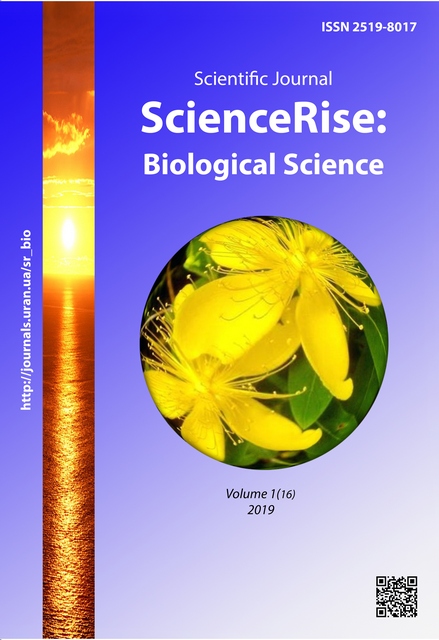Structural-functional state of kidneys of rats of two generations when using glyphosate-resistant genetically modified soy and herbicide Roundup
DOI:
https://doi.org/10.15587/2519-8025.2019.160170Keywords:
biotechnology, traditional soya, transgenic, glyphosate-resistant, kidneys, herbicide, glomeruli, hydrophilic swellingAbstract
Due to the widespread use of transgenic soy and the Roundup herbicide, we conducted histological studies of the kidneys of two generations of rats that received genetically modified soybean "Roundup Ready", not treated with a herbicide, the same genetically modified soybean, treated with a herbicide and the "Roundup" herbicide together with drinking water.
Materials and methods. The subjects of the study were male rats of the Wistar line at the age of 4 months, weighing 180-200 g. The experimental animals were grouped into 5 groups of 12 rats each (6 females and 6 males): Group I - the intact animals (kept on a standard vivarium diet); Group II – the animals with up to 26% of standard diet nutritional value, replaced by traditional soybean; Group III - the rats with up to 26% of the standard diet, replaced by genetically modified soybeans, not treated with the herbicide Roundup; Group ІV – the rats, fed with feed containing up to 26% of genetically modified soybean, treated with the herbicide Roundup; Group V – the rats, received the herbicide Roundup with drinking water at a concentration (0.1 μg / L). After 42 days, all groups of rats were paired, and thus the second generation was obtained. At the age of 12 months, the rats of all groups were decapitated, and pieces, selected from the middle part of the kidneys (indicate which ones), then these pieces were fixed in 10 % neutral solution of formalin for 48 hours. At performing morphological studies, commonly used histological techniques were used.
Results. The evaluation of histopathological changes in the kidneys of the experimental animals, fed with genetically modified soybean, not treated with the Roundup herbicide (Group III), the ones, fed with transgenic soybean, treated with a herbicide (Group IV), and the ones received the Roundup herbicide with water (Group V) was realized. The analysis of histological sections of the kidneys in all rat groups showed changes in the structure of the kidneys in the IV and V groups. As a result of the experiment, reversible swelling of the renal tubule epithelium in these groups and signs of necrosis of individual cells in the first generation of rats were noted, and in the second generation there was a destruction of the tubule cells and a violation of their functions.
Conclusions. The use of genetically modified soybean, treated with the herbicide «Roundup» and herbicide, results in the loss of the structure of renal glomeruli and in the disruption of their functions, both in the first and second generation. Such results indicate a negative effect of the herbicide on the rat's organism and its ability to accumulate in soybean seeds
References
- Sapozhnikov, A. G., Dorosevich, A. E. (2000). Histological and microscopic techniques. Smolensk: SAU, 476.
- Kotsyubbas, G. I., Samsonyuk, I. M. (2011). Genetically modified organisms and their distribution in the world. Scientific herald of LNUVMBT named after S. Z. Gzhytsky, 13 (4 (50)), P. 1, 182–186.
- James, C. (2013). Global status of commercialized blotech GM croup. Ithaha: ISAAA Brief, 244, 24–28.
- Saliga, N. O., Snitinsky, V. V. (2010). Genetically modified plants and their influence on the organism of animals. Biology of Animals, 12 (2), 61–74.
- European convention for the protection of vertebrate animals used for experimental and other scientific purposes (1986). Strasbourg: Council of Europe, 53.
- DSTU ISO 21569: 2008 «Methods of detection of genetically modified organisms and products with their content. Qualitative methods based on nucleic acid analysis" (ISO21569: 2005, IDT). Available at: https://www.twirpx.com/file/1530836/
- DSTU ISO 21570: 2005 "Foodstuffs. Methods of detecting genetically modified organisms and products with their content. Quantitative Methods Based on the Analysis of Nucleic Acids" (ISO21570: 2005, IDT). Available at: https://www.twirpx.com/file/1530831/
- Ferreira, T., Rasband, W. (2012). ImageJ User Guide. New York: National Institute of Health, 187.
- Gozhenko, A. I., Filipets, N. D., Davydenko, I. S. (2014). Peculiarities of structural-functional changes of kidneys after modulation of ionic channels under conditions of chronic exotoxic nephropathy. Bulletin of morphology, 20 (2), 357–361.
- Vlasik, L. I., Andriychuk, N. Ya., Davidenko, I. S. (2014). Peculiarities of pathomorphological changes in internal organs of rats as a result of the acute effects of silver nanocardrons. Clinical and Experimental Pathology, 13 (3 (49)), 33–36.
- Dolaychuk, O. P., Fedoruk, R. S., Kovalchuk, I. I., Khrabko, M. I. (2013). Physiological influence of soybeans of native and transgenic varieties on the body of females of third generation rats. Biology of animals, 15 (3), 22–30.
- Dumukhalskaya, E. B. (2015). Structural changes of internal organs in young rats infected with heavy metal salts and organophosphorus pesticides. Medical and Clinical Chemistry, 17 (2), 47–51.
Downloads
Published
How to Cite
Issue
Section
License
Copyright (c) 2019 Iryna Chorna

This work is licensed under a Creative Commons Attribution 4.0 International License.
Our journal abides by the Creative Commons CC BY copyright rights and permissions for open access journals.
Authors, who are published in this journal, agree to the following conditions:
1. The authors reserve the right to authorship of the work and pass the first publication right of this work to the journal under the terms of a Creative Commons CC BY, which allows others to freely distribute the published research with the obligatory reference to the authors of the original work and the first publication of the work in this journal.
2. The authors have the right to conclude separate supplement agreements that relate to non-exclusive work distribution in the form in which it has been published by the journal (for example, to upload the work to the online storage of the journal or publish it as part of a monograph), provided that the reference to the first publication of the work in this journal is included.









